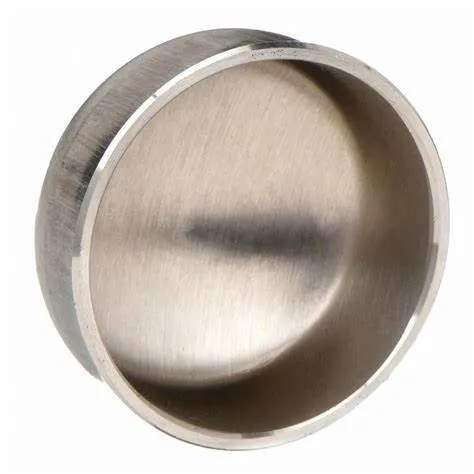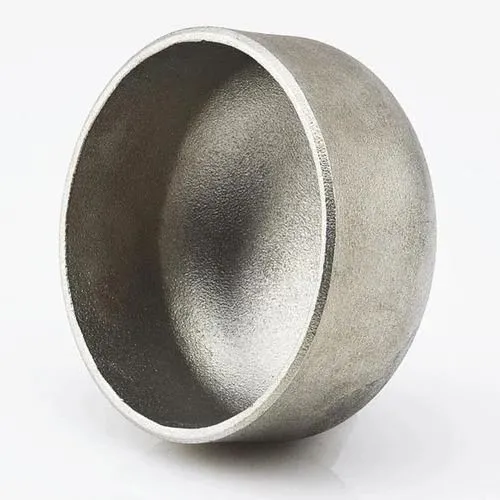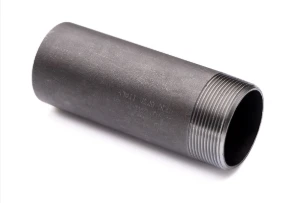JIS B2311 ni Kiwango cha Viwanda cha Kijapani ambacho hufunika vifaa vya mabomba ya kulehemu kitako, ikiwa ni pamoja na vifuniko vinavyotumika katika mifumo ya mabomba. Vifuniko vya kulehemu vya kitako hutumikia kusudi la kufunga mwisho wa bomba, kutoa muhuri ili kuzuia kuvuja au uchafuzi. Hapa kuna utangulizi wa kofia za kulehemu za JIS B2311:
- 1. JIS B2311 Standard:
- - Kiwango cha JIS B2311 kinabainisha mahitaji ya muundo, vipimo, nyenzo, utengenezaji, na majaribio ya vifaa vya kulehemu vya kitako, pamoja na kofia, katika mifumo ya bomba.
- - Kiwango hicho huhakikisha kuwa vifuniko vinavyozalishwa kwa kufuata viwango vya JIS vinakidhi viwango vya ubora na vinaoana na vipengele vingine vya mabomba.
- 2. Kifuniko cha Kuchomelea kitako:
- - Kofia ya kulehemu kitako, kulingana na JIS B2311, ni kifaa cha kufaa kilichoundwa kufunika na kuziba mwisho wa bomba kwa usalama, kutoa ulinzi na kudumisha uadilifu wa mfumo wa mabomba.
- - Caps hutumiwa katika hali ambapo mwisho wa bomba unahitaji kufungwa, ama kwa kudumu au kwa muda, ili kuzuia kuvuja, uchafuzi, au kutoa kumaliza kwa mfumo.
- 3. Nyenzo na Ujenzi:
- - Kofia za kulehemu kitako chini ya vipimo vya JIS B2311 zinapatikana katika nyenzo mbalimbali kama vile chuma cha kaboni, chuma cha pua na aloi ili kukidhi mahitaji tofauti ya utumizi.
- - Kofia hizi zinatengenezwa kwa kutumia mbinu za ujenzi zilizosanifiwa ili kuhakikisha muunganisho wenye nguvu na usiovuja wakati wa kuunganishwa hadi mwisho wa bomba.
- 4. Maombi na Faida:
- - Kofia za kulehemu kitako hupata matumizi katika sekta mbalimbali, ikiwa ni pamoja na mafuta na gesi, michakato ya kemikali, mitambo ya kutibu maji, na zaidi ambapo miisho ya mabomba inahitaji kufungwa kwa usalama.
- - Kofia hutoa ulinzi kwa ncha za bomba kutoka kwa vipengele vya mazingira, kuzuia uchafuzi, na kusaidia kudumisha usafi na uadilifu wa mfumo wa mabomba.
- 5. Ufungaji na kulehemu:
- - Mbinu sahihi za ufungaji, ikiwa ni pamoja na upangaji sahihi, utayarishaji wa mwisho wa bomba, na mbinu za kulehemu, ni muhimu wakati wa kufunga vifuniko vya kulehemu vya kitako ili kuhakikisha muhuri mkali na usiovuja.
- - Kulehemu ni njia ya kawaida ya kuunganisha kofia kwenye mabomba, kutoa kufungwa kwa usalama na kudumu ambayo inaweza kuhimili shinikizo, tofauti za joto, na mtiririko wa maji ndani ya mfumo.
- Kwa muhtasari, kofia za kulehemu za JIS B2311 ni sehemu muhimu zinazotumiwa katika mifumo ya bomba ili kuziba na kulinda mwisho wa mabomba kwa usalama. Kofia hizi zinaafikiana na mahitaji sanifu ili kuhakikisha ubora, kutegemewa, na utangamano ndani ya programu za viwandani ambapo kufungwa na ulinzi wa bomba ni muhimu.
What Is a Butt Welding Cap and How Is It Used in Industrial Piping?
In industrial piping systems, end-of-line sealing and branch closures require robust solutions. A butt welding cap serves as a critical component for terminating pipes securely. By providing a seamless, welded closure, this fitting maintains system integrity, prevents leaks, and supports compliance with industry standards.
What Is a Butt Welding Cap?
A butt welding cap—also called a pipe end cap or buttweld end cap—is a round fitting designed to close off the end of a pipe. It’s manufactured to match the pipe’s outer diameter and schedule, with either a hemispherical or flat face. To install, both the pipe end and cap are beveled to form a V‑groove, enabling full‑penetration, fusion welds. Common materials include carbon steel, stainless steel, nickel alloys, and other engineered grades, chosen to satisfy pressure, temperature, and corrosion‑resistance requirements.
How Is Butt Welding Cap Used in Industrial Piping?
Butt welding caps find application across oil & gas, petrochemical, power generation, water treatment, and general process industries for both permanent and temporary closures. During hydrostatic testing, technicians install caps to seal off sections of piping while monitoring for leaks. In new construction or retrofit projects, caps terminate branch lines, future tie‑in spools, or dead‑end mains until system expansion. Welders prepare each joint by cleaning and beveling surfaces, aligning the cap precisely, and executing a root pass followed by filler passes per the qualified Welding Procedure Specification (WPS). Post‑weld heat treatment and non‑destructive examination (NDE)—such as radiography or ultrasonic testing—verify weld integrity and compliance with ASME B16.9 and related standards. Additionally, temporary caps enable safe isolation during maintenance, allowing for segment testing and dewatering under regulatory protocols.
Benefits and Best Practices
Butt welding caps offer a smooth‑bore transition that minimizes flow disruption and stress concentration. Their full‑penetration welds deliver exceptional structural strength and leak resistance. To optimize performance, engineers should:
Select caps with matching material grades and wall thicknesses
Adhere to proper bevel angles and joint fit‑up tolerances
Follow qualified WPS protocols rigorously
Consider cladding or protective coatings in corrosive environments to extend service life
Regular inspection and thorough documentation ensure long‑term reliability and safe operation under demanding conditions.
Butt welding caps are indispensable components for achieving durable, leak‑proof pipe terminations in a wide range of industrial applications.
Butt Welding Cap FAQs
What is a butt welding cap?
|
What materials are commonly used?
|
What standards govern butt welding caps?
|
How are butt welding caps installed?
|
Where are butt welding caps typically used?
|
What are the advantages of threaded caps?
|
















